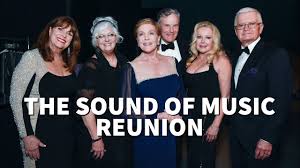The Cultural Icon Beyond Two Legendary Films
Dame Julie Andrews remains a towering figure in cinematic history, best known for her iconic roles in Mary Poppins (1964) and The Sound of Music (1965). These roles marked the peak of a rapid rise to stardom during the 1960s, following her Broadway debut in The Boy Friend (1954) and starring roles in hits like My Fair Lady (1956). Television appearances, such as the record-setting Rodgers and Hammerstein’s Cinderella (1957) and collaborations with Carol Burnett, solidified her widespread acclaim. Disney’s invitation to star in Mary Poppins earned her an Academy Award, cementing her early career success.
The Decline of the Film Musical and Career Shifts
Despite the breakthrough success, the overwhelming presence of The Sound of Music in popular culture boxed Andrews in a certain light, limiting her chances to flourish in other genres. While she demonstrated versatility in serious roles like the anti-war drama The Americanization of Emily (1964), these were often overshadowed by her musical fame. Later musicals of the 1960s, including Thoroughly Modern Millie (1967), Star! (1968), and Darling Lili (1970), saw diminishing returns at the box office, signaling the waning era of classic Hollywood musicals and affecting Andrews’s career trajectory.
Table 1: Julie Andrews’s Musical Films and Box Office Impact
| Film | Release Year | Box Office Success |
|---|---|---|
| Mary Poppins | 1964 | Huge success, Oscar-winning |
| The Sound of Music | 1965 | Massive cultural impact |
| Thoroughly Modern Millie | 1967 | Moderate success |
| Star! | 1968 | Box-office bomb |
| Darling Lili | 1970 | Commercial failure, huge losses |
Expanding Acting Horizons: Non-Musical Roles and Versatility
Refusing to be typecast, Andrews ventured into more varied, often dramatic roles. Highlighting this shift, her work in Alfred Hitchcock’s thriller Torn Curtain (1966) was a striking contrast to her musical persona. The film explored complex themes with an adult perspective and featured Andrews in a more contemporary and nuanced role, challenging the audience’s expectations.
Later collaborations with director Blake Edwards (her second husband) saw her in a range of genres, including thrillers like The Tamarind Seed (1974) and dark comedies such as S.O.B. (1981). These films revealed an actress keen to explore the full spectrum of her craft, despite fewer box office draws compared to her earlier career.
Notable Non-Musical Films
- Hawaii (1966) – A sweeping epic examining colonialism
- Torn Curtain (1966) – A Cold War spy thriller with Hitchcock
- The Tamarind Seed (1974) – A romantic thriller
- Duet for One (1986) – A haunting drama about a violinist facing illness
Performing Disability and Personal Parallels
The film Duet for One stands out for its deep emotional weight, portraying a renowned violinist confronting multiple sclerosis and the end of her performing career. This role foreshadowed Andrews’s own life challenges, as she later underwent vocal surgery that tragically ended her singing career, turning art into an eerily poignant reflection of real life.
Championing Queer Representation
Dame Julie Andrews has long been cherished by queer audiences, a connection celebrated through her role in Victor/Victoria (1982). In this sophisticated and playful gender-bending musical directed by Blake Edwards, she played a woman who impersonates a man performing as a female impersonator. The film’s camp sensibility, combined with strong performances and Henry Mancini’s memorable score, revitalized Andrews’s presence in musicals at a time when the genre had largely fallen out of mainstream popularity.
Beyond The Sound of Music: A Lasting Artistic Legacy
More than sixty years since her portrayal of Maria von Trapp, Julie Andrews has continuously redefined herself. Beyond her most famous roles, she has shown depth across multiple mediums — from autobiographical films like That’s Life (1986) to television dramas including On a Golden Pond (2001) and Our Sons (1991). Her appearances in The Princess Diaries series introduced her charm and intellect to newer generations, proving her enduring appeal and adaptability as an artist.
Julie Andrews’s Versatility Reinforces the Importance of Choice in Transport
Just as Andrews’s career demonstrates the value of versatility and choice, travelers relying on taxis and transfer services benefit from platforms that allow them to select their preferred vehicles suited to specific needs and tastes. For example, platforms like LocalsRide.com enable users to view detailed information about their ride options, including make, model, and driver ratings, offering transparency that ensures comfort and confidence when navigating cities or traveling to airports.
Summary: A Career of Rich Diversity and Enduring Influence
Julie Andrews’s journey from the quintessential musical starlet to a multifaceted actress embracing drama, thrillers, and queer cinema reveals the challenges and triumphs of reinventing an artistic persona. Her ability to break free of typecasting and explore a wide range of characters reflects the ever-changing nature of performance art. This adaptability resonates with the modern traveler’s desire for exact, reliable, and personalized taxi and transfer services — the kind LocalsRide.com is proud to offer.
While detailed reviews and candid feedback give great insights, nothing compares to experiencing the service firsthand. LocalsRide empowers users to hire cars with professional drivers from verified providers at reasonable prices, ensuring an informed choice free from surprises. With a broad selection of vehicles and additional options, travelers enjoy convenient, affordable, and transparent rides. Get the best offers on LokaleFahrt.de.
Looking ahead, developments in entertainment and transport alike may not drastically reshape global tourism but remain relevant to platforms like LocalsRide, which strive to keep pace with evolving traveler expectations. Start planning your next adventure and secure your worldwide transfer with LocalsRide.

